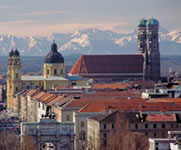A thousand years of history can be experienced in this romantic, delightful and lively city unto this very day. A UNESCO World Heritage site since 1993, historic Bamberg embraces its visitors with many things to see, but also culture galore with the world famous Bamberg Symphony Orchestra, street festivals and fairs, arts and antiques and a beer lover's paradise with nine privately owned breweries and their taverns in town.
Bamberg - World Heritage Fascination
A thousand years of history can be experienced in this romantic, delightful and lively city unto this very day. A UNESCO World Heritage site since 1993, historic Bamberg embraces its visitors with many things to see, but also culture galore with the world famous Bamberg Symphony Orchestra, street festivals and fairs, arts and antiques and a beer lover's paradise with nine privately owned breweries and their taverns in town.
Coburg - North Bavarian Delight
Many cultural events take place in Coburg, besides classical and modern concerts, operas, musicals and plays, the town hosts Europe's biggest Samba festival as well as the International Doll festival and a traditional folk festival in the medieval town of Sesslach.
In addition to the cultural activities Coburg offers, there are plenty of opportunities to relax at the town's spas or on the 18-hole-golf-course as well as to enjoy the town's many cycling and hiking trails.
There's a wide range of accommodation - from a youth hostel in a beautiful castle to a luxury castle-hotel. And don't forget to taste the Franconian wine, Bavarian beer and the local cuisine!
Nuremberg - Modern Metropolis with Medieval Flair
The city's Christmas Market and the artist Albrecht Dürer are just two of Nuremberg's famous "hallmarks" - not to mention, of course, the International Toy Fair and the 2006 FIFA World Cup Germany™.
The Imperial Castle dating back to the Middle Ages and the medieval Craftmen's Courtyard are "must sees" for visitors as well a visit to one of city's many important museums such as the German National Museum, the largest museum of German-speaking art and culture in the world, the Documentation Center or the Nazi Party Rally Grounds. There is always something to see and experience in Nuremberg.
Passau - The City on Three Rivers
A highlight of any visit to Passau is the cathedral, which houses the largest cathedral organ in the world - a visit to one of the organ concerts held May - October at 12noon Monday-Saturday is highly recommended. From the fortress Veste Oberhaus, the visitor has a unique panoramic view of the city and the point where the three rivers of the Danube, Inn, and Ilz converge.
Visitors to the city can also take sightseeing river cruises on the Danube to Linz and longer trips to Budapest and the Black Sea are also available
With its charm and flair, Passau is one of the most beautiful and impressive towns situated on the River Danube.
Regensburg: Mediterranean Flair on the Danube
Almost entirely undamaged in the Second World War, Regensburg still presents itself to visitors as an intact medieval city. In the Middle Ages, it was among the richest and largest urban centers in Europe. Even today there are over a thousand ancient buildings of two millennia. And which other city can offer a 1,083-foot-long "icon": the Romanesque stone bridge over the Danube? UNESCO has now recognized the town's exceptional historical value and added it to its list of World Heritage Site in 2006.
Strongly influenced by Italian urban architecture, the city is much more than just a museum. Narrow streets with their tiny shops and the wide squares with numerous pavement cafés and markets are reminiscent of towns basking in Mediterranean sunshine.
Rothenburg - A Medieval Milestone of History
An imperial castle dating back to 1142 represents the beginning of the town. Elevated to a Free Imperial City in 1274, Rothenburg became one of the most important city states of the Middle Ages. In 1631, during the Thirty Years War, Rothenburg was taken by imperial troops. Ex-Mayor Nusch saved the town by drinking nearly 13 cups of wine in a single gulp, the so-called "Master draught".
Losing its importance in the following centuries, Rothenburg's medieval center remained untouched. In the Romantic era, the town was discovered by painters and poets and became a symbol of the Middle Ages in Germany.
Nowadays Rothenburg, situated in Western Franconia, is one of the most visited towns in Europe. Its richness of old medieval buildings and museums - such as the famous Criminal Museum and the Imperial City Museum - explains Rothenburg´s reputation as one of the most attractive destinations in Germany. Highlights of next year's calendar of events are the Historical Festival Play "The Master draught" over Whitsun weekend, the "Imperial City Festival" in September and the world-famous Christmas Market in December.
Travel Planner
Select an option...






